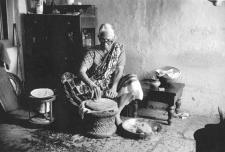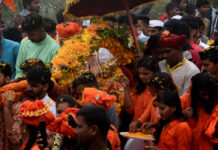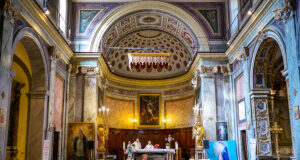Joyce Shankaran with friends and family in Bombay (L to R): Ruth Varsulkar, Joyce’s niece; Esther Talkar, Joyce’s friend; Elizabeth Abraham, Joyce’s mother; Joyce; Anu, Joyce’s daughter.
The “Baghdadis,” referring to Jews coming mainly from Baghdad, Basra and Aleppo, but also from other Arabic speaking parts of the Ottoman Empire, arrived in India in the late eighteenth century and ultimately formed important diaspora trading communities in Bombay and Calcutta. The Baghdadi population of Calcutta peaked in the early 1940s at about 3800 including the 1200 refugees who arrived from Burma in 1942. There were perhaps another three thousand in Bombay and Pune. The Baghdadi Jewish community in India was unique. Its people adhered to Iraqi or Syrian traditions and customs but embraced an English lifestyle and education, while exuding the warmth and hospitality of India, all at the same time. Although constrained by convention and subordinate to males, Baghdadi women made their mark. In Calcutta several wrote memoirs or books in which they collected the memories of many community members. Unfortunately the Bombay Baghdadi community has not yet spawned such writers.
Originally following a more Middle Eastern lifestyle, by the second half of the nineteenth century the Baghdadi elite started to discard its “Oriental” customs and began to assimilate more to the British. By the early 1900s, although still speaking Judaeo-Arabic, with which they could communicate with their kinfolk and business relations throughout the East, most also knew English, especially the younger generation. One might hear Hindustani, Arabic and English in their homes, with the addition of Bengali in a Calcutta Baghdadi home. The lower classes retained a strong Judaeo-Arabic cultural identity for longer than the middle or upper classes. Nevertheless, whatever external environments they adapted to, whether Arab, Indian or British, their Jewishness remained at the core of their identity.
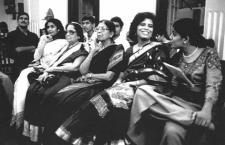 Having less social interaction with westerners than their husbands, the women probably changed more slowly, continuing Baghdadi traditions in their homes. Even after they started to adopt an Anglicized life-style, traditional clothing, such as the “wrappers,” loose ankle-length dresses with loose sleeves and frills and lace, was maintained, especially by the less affluent, perhaps into the 1920s. Rarely were saris worn. Baghdadi Jewish food originally had many Arab elements, but in India Muslim cooks taught their Baghdadi “memsahibs” to use Indian spices in their traditional dishes. There was much more Muslim and Hindu than British influence on their food. Soon Baghadi Jewish cooking was distinct from that of other Indian communities. By the beginning of the twentieth century, affluent Baghdadi women decorated their homes in British fashion. Brides began to wear modern western wedding gowns and the receptions were similar to those of the British.
Having less social interaction with westerners than their husbands, the women probably changed more slowly, continuing Baghdadi traditions in their homes. Even after they started to adopt an Anglicized life-style, traditional clothing, such as the “wrappers,” loose ankle-length dresses with loose sleeves and frills and lace, was maintained, especially by the less affluent, perhaps into the 1920s. Rarely were saris worn. Baghdadi Jewish food originally had many Arab elements, but in India Muslim cooks taught their Baghdadi “memsahibs” to use Indian spices in their traditional dishes. There was much more Muslim and Hindu than British influence on their food. Soon Baghadi Jewish cooking was distinct from that of other Indian communities. By the beginning of the twentieth century, affluent Baghdadi women decorated their homes in British fashion. Brides began to wear modern western wedding gowns and the receptions were similar to those of the British.
Arranged marriages were the custom through the 1930s, although there were also love marriages. The morality and chastity of the women determined whether a family was “good” or “bad.” Girls often married in their late teens until the mid-twentieth century, after which it was generally in their early twenties. Spouses might be sought in any part of the Baghdadi diaspora and were often related. Brides used the mikveh, often for the first and only time, just before their weddings. Divorce was rare, as was polygamy.
In the nineteenth century girls studied at home, concentrating on Hebrew and Torah, with Arabic the main language of instruction. By the early years of the twentieth century, they went to English-language schools. In Bombay, those Baghdadis who lived in and near Bycullah, a working class neighborhood, attended the Sassoon Schools, which taught Hebrew and observed Jewish holidays. The wealthier members of the community lived in the Fort area and sent their daughters to private, often Christian-run schools which prepared for the overseas Cambridge school certificate examinations. In Calcutta, lower and middle class girls attended the Jewish Girls School, founded in 1881, while those from the upper class were sent to private schools.
In Calcutta, some women were noted for their philanthropy. Mozelle Ezra (1853–1922), the daughter of Sir Albert Sassoon and the wife of the community leader and philanthropist Elia Ezra, tried to ease the poverty in the Jewish community and donated a great deal of money to the synagogues and schools. In 1887 she established the Ezra Hospital, open to all communities but with special provisions for Jews, in honor of her late husband. She also contributed to support women, children, students and other causes in Jerusalem, as well as to the maintenance of the tomb of Ezra in Iraq. Her son, Sir David Ezra (1871–1947), assumed his father’s position in the community and his wife, Lady Rachel Ezra (l877–1952), the daughter of Flora Sassoon of Bombay, continued in the tradition of her mother-in-law. The community matriarch in the first half of the twentieth century, Lady Rachel worked for the cause of social welfare, presiding over several of the community’s institutions as well as wider Bengali ones. In 1947 the British government awarded her the Kaiser-I-Hind Gold Medal. Very supportive of all classes of the Calcutta community, she made up the debt for many activities such as weddings and sports. Her home became a communal center where British and Indian officials met and Jewish activities, such as charitable events, wedding receptions and Zionist youth functions, took place. She and her husband were known for their philanthropy, including their contributions to Zionist funds. During the two world wars she opened her home to allied Jewish servicemen and women stationed in Calcutta. Over one thousand of these served in the city during World War II and some of the men took home Baghdadi war brides. The Ezras also took the lead in welcoming and rehabilitating European Jewish refugees who started arriving in 1939.
A number of fairly well-off women in both cities functioned as informal social workers among the poor. In Calcutta, the Jewish Women’s League was founded in 1913 and played an important role in social welfare. A similar league existed in Bombay, headed by Georgette Ani (1895–1975), who came to the city in 1919 as a bride in an arranged marriage with a man she had never met. Ani was president of the Jewish Women’s League for many years, taking it upon herself to supply and oversee hot meals served daily to the students at the Sir Jacob Sassoon High School for Baghdadi Jews. She also supervised the serving of kosher meals in the Jewish ward of the J. J. Hospital and supported Youth Aliyah. In Bombay, however, the Sassoon trusts, including those established by Lady Rachel Sassoon, weakened the incentive to form other organizations. The trusts would provide poor girls with a trousseau to help them get married. Shahi Abraham (b. 1909), a former teacher, is still the managing trustee of the Sir Sassoon J. David Trust Fund in Bombay. She presides over donations of money, medicine, food and clothing to Baghdadi and Bene Israel Jews. If necessary, she accompanies recipients to medical centers and hand-delivers money and medicine to their homes.
Born in Calcutta, Kitty Sopher (1910–2001) came to Bombay after her marriage. A pillar of the Jewish community, she touched many young lives through Habonim (youth camps) in Matheran and Mahablishwar which she organized and ran during school vacations. The camps emphasized Jewish studies and built team spirit; many Bombay Jews, now living all over the world, fondly recall these childhood memories. Hundreds of trees have been planted in Israel in Kitty Sopher’s memory and a library in her honor has been established at Mevasseret Zion.
Originally it was not considered proper for women to work outside the home, except as teachers and dressmakers. Flo Hayim (b.1910), known as Madam Hayim, was synonymous with high fashion in Bombay. Born in that city, she grew up in Matheran Pedestrian Hill Station, where she and her sister apprenticed with the local darzi (tailor). An established couturière, Madam Hayim designed and made her own line of dresses in Bombay. Daily sewing classes in her house were attended by the elite of the city. Many of today’s leading dressmakers in India were her pupils. Although she was very successful, Madam went out of her way to teach her craft to poor Jewish girls as a way of helping them to gain independence. Flo Hayim was versatile, informed, articulate, sophisticated and well traveled. She even owned her own horse, which she rode at the racecourse until her late seventies.
Many Baghdadi women became teachers, finding jobs in Anglo-Indian or “convent” schools. In Calcutta, Rahma Luddy, who received a Teachers’ Diploma from London, was the principal of the Jewish Girls School from 1929 to 1963. Under her leadership, it was considered one of the best high schools in the city and became a center of Jewish communal life. Luddy introduced the teaching of modern Hebrew in the school in the 1930s; it eventually became a subject for the Cambridge External Examinations. Luddy served the community in many other fields, including the Jewish Women’s League, the Judean Club and the Young People’s Congregation and was remembered with great respect and affection and honored by former pupils all over the world for many years.
In Bombay, Mrs. E. Joseph became the headmistress of the Sir Jacob Sassoon Free School in 1925. Seen in the early years as a charitable institution for poor Jewish children, the school improved during her tenure. Enrollment increased and children from more affluent families began to attend. Another Baghdadi educator in Bombay was Sophy Kelly (1917–2002) who had also studied in England. Known as the Queen of Peddar Road, she was a pioneer educator, the founder and principal of the private Hill Grange High School, not a specifically Jewish school. She wore a sari at all times, which was unusual for a Baghdadi woman. She was president of the B’nai Brith women’s auxiliary and had a close association with many political figures, including Nehru and Indira Gandhi. In 1965 she was appointed justice of the peace in Bombay. In 1985 she arranged for the president of India, G. N. Singh, to inaugurate the centenary celebration of the Knesset Eliahoo Synagogue in Bombay. Miss Kelly, as she was known, hosted many functions in her home, where her table was always laden with Baghdadi delicacies.
Hannah Sen (1894–l957), the daughter of a Baghdadi mother and a prominent Hindu lawyer who converted to Judaism, made her mark in a wider arena. She graduated with a law degree but chose education as her profession. Starting out as a teacher in the Jewish Girls School in Calcutta, she became the first Indian principal of the New High School for Girls in Bombay in l922. While earning her Teacher’s Diploma from the University of London, Hannah Sen was closely associated with some of the leading British women’s organizations. She gave many speeches, including one in front of a large number of British Members of Parliament, on the conditions and problems of Indian women. In l932 she was asked to return to India to help found the Lady Irwin College of Home Science in New Delhi, of which she served as principal until l947. Under her leadership, this college was heavily involved in the Indian nationalist movement—something with which most Baghdadi women, like their male counterparts, did not identify. Sen later worked with the Ministry of Relief and Rehabilitation, focusing on women and children who were displaced as a result of the partition of the sub-continent. She continued her interest in social affairs by representing India at international conferences of non-governmental organizations, UNESCO, and the United Nations Commission on the Status of Women. Hannah Sen remained close to the Jewish community and contributed to the building of the synagogue in New Delhi.
Florence Haskell edited the Baghdadi newspaper Zion’s Messenger in Bombay in the 1920s.
After World War I Baghdadi girls wanted to go to college in order to be able to find different types of employment. Many hoped to become clerks or secretaries for British firms and by the late 1930s they began to work as secretaries for international firms or, in the 1940s in Calcutta, for the Allied forces, who employed many Baghdadi women. By 1947 perhaps a quarter of the Jewish women in Calcutta were active in economic and professional life.
Despite some parental and communal raised eyebrows, several Baghdadi women, such as Sulochana (Ruby Meyers) (1907–1983), Ramola, Pramilla (Esther Victoria Abraham), Rose and Nadira (Florence Ezekiel, 1932–2006), became stars in early Hindi films, especially during the silent film period. Nadira was particularly known for her roles as a vamp. Later, Mercia Solomon Mansfield (b. 1916) was active in British theatre, television and films. Pearl Padamsee (1930–2000), the daughter of a Baghdadi Jewish mother and a Christian who became the ambassador to Australia, promoted the “English theatre” in Bombay. She reproduced successful Broadway productions using local Indian talent. She directed, acted and produced for the stage, schools and organizations. Married first to a Bengali Hindu, then to a well-known Muslim personality, Pearl was a part of every English theatre presentation. She raised the money for and established a successful rehabilitation center for drug addicts.
There were other ways to serve the community. Sameha (1889–1982) was born in Baghdad. Upon the promise of a good match, this illiterate woman was sent to Bombay as the wife in an arranged marriage. Sameha’s husband turned out to be a gambler and a drunkard who abandoned her when she gave birth to their daughter. Sameha refused charity. She set out on her own, establishing herself as a Baghdadi pastry chef, specializing in the baking in a clay oven of machboz, a light pastry stuffed with cheese, dates and walnuts, and the making of feta cheese. Carrying the goods in a basket on her head Sameha sold to most of the Baghdad households in Bombay from the 1950s to the 1970s. Eventually she became a matchmaker and moneylender. She helped her daughter emigrate to London where she later joined her, continuing to bake machboz for Baghdadi families in London.
Only brief mention can be made of Calcutta Baghdadi women who achieved recognition after leaving India. Iris Morris Ferris (1910–1970) rose to the position of General Secretary in the London headquarters of the Girl Guides movement. Rina Einy (b. 1965) represented England in tennis in the 1984 Olympics. Sally Meyer Lewis was a professor of biology in the United States. Jael Silliman and Maisie Meyer are academics who write about Baghdadi in India and Shanghai respectively. As time goes by, descendants of the Baghdadi Jews of India will no doubt make their mark in a variety of fields.
IMAGES:
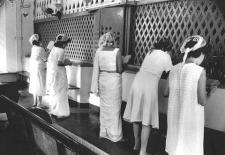
Women praying in the women’s section of the synagogue in Cochin.
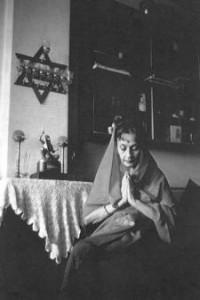
Leading film star Nadira, famous for her portrayal of the “vamp,” at home in Bombay.
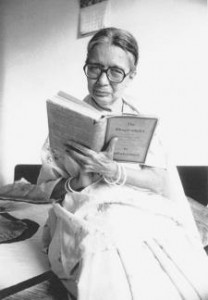
Sanskrit scholar Esther Solomon, Amhedehad, India.
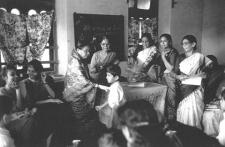
Women active in Shri Mandal, a women’s volunteer organization founded in 1913 by Dr. Jerusha Jhirad, distribute presents to needy children at a Hannukah party in Bombay.
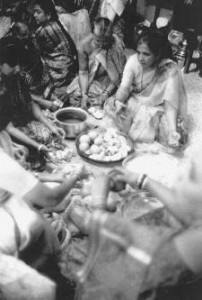
Women at a Melida ceremony, an offering to Elijah the Prophet.
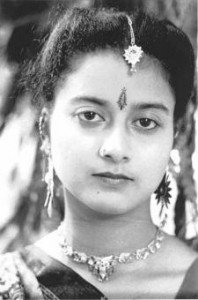
Dancer at a wedding ceremony in Bombay.
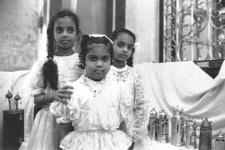
Young girls celebrating Simhat Torah in the Magen Hassidim Synagogue, Bombay.
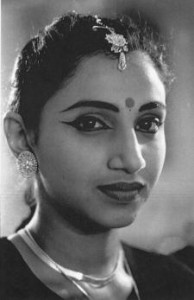
Reem Sisodia, a Baghdadi Jew who studied and performed Kathak (classical) Indian dance. This photograph was taken in Bombay.
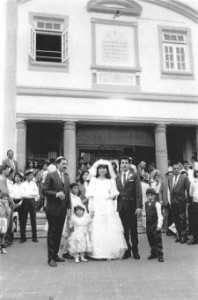
Bride and groom and family, after their wedding ceremony at the Magen Hassidim Synagogue in Bombay.
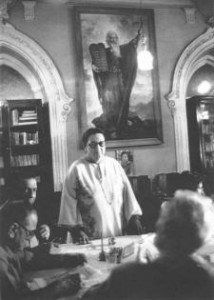
The “Queen of Peddar Road,” pioneer educator Sophy Kelly founded the private Hill Grange High School, served as a justice of peace in Bombay, and maintained close associations with key political figures in India. “Miss Kelly” was known for the elaborate functions she hosted, including the one pictured here, a meeting for government officials held at Hill Grange school.
To see the original source and author of this please go to this URL:
http://jwa.org/encyclopedia/article/baghdadi-jewish-women-in-india

